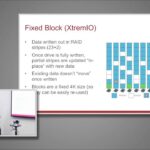|
|

Dave Wright presented for SolidFire at SFD5 |

This video is part of the appearance, “SolidFire Presents at Storage Field Day 5“. It was recorded as part of Storage Field Day 5 at 13:00-15:00 on April 24, 2014.
Watch on YouTube
Watch on Vimeo
In this Tech Field Day presentation recorded on April 24, 2014, SolidFire CEO and Founder Dave Wright delves into the architectural design decisions and trade-offs of three major all-flash storage systems: SolidFire, EMC XtremIO, and Pure Storage. Wright emphasizes the importance of understanding the strengths and weaknesses of different architectures rather than simply claiming superiority. He categorizes the flash market into three segments: flash appliances with basic feature sets, legacy array retrofits, and native all-flash arrays with full enterprise feature sets. Wright argues that traditional disk architectures are poorly suited for flash due to issues with deduplication, compression, and RAID performance, necessitating new architectures for flash storage.
Wright compares the scale-up and scale-out designs of these systems. He explains that scale-up architectures, like those used by Pure Storage, are familiar to many administrators and involve upgrading to more powerful controllers and adding more disk shelves for capacity. However, this approach can lead to imbalances between capacity and performance. In contrast, scale-out architectures, used by SolidFire and XtremIO, scale performance and capacity together by adding more nodes or bricks. SolidFire’s unique approach allows for different node types to achieve a balance of capacity and performance, avoiding the stranding of resources as the system expands. Wright highlights that scale-out models are better suited for larger, unpredictable workloads, while scale-up models are more appropriate for small, fixed, predictable workloads.
The presentation also covers system redundancy, data organization, and power loss protection. Wright contrasts the dual-controller, shared-disk shelf model used by Pure Storage and XtremIO with SolidFire’s shared-nothing architecture, which eliminates single points of failure. He explains the different methods of data organization and IO paths, noting that SolidFire and XtremIO use a content-based approach, while Pure Storage uses a location-addressed approach. Wright also discusses the importance of power loss protection, with SolidFire using PCIe NV-RAM devices to ensure data integrity. He concludes by summarizing the trade-offs and optimizations of each system, emphasizing SolidFire’s focus on scale, availability, and cost-effectiveness for large-scale, next-generation data centers.
Personnel: Dave Wright








